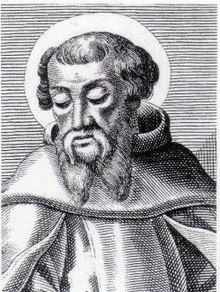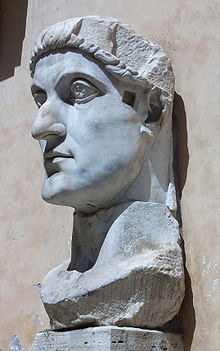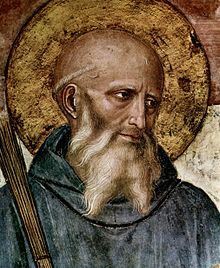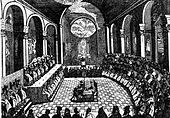
A | B | C | D | E | F | G | H | CH | I | J | K | L | M | N | O | P | Q | R | S | T | U | V | W | X | Y | Z | 0 | 1 | 2 | 3 | 4 | 5 | 6 | 7 | 8 | 9
| Part of a series on the |
| Catholic Church |
|---|
 |
| Overview |
|
|
The tradition of the Catholic Church claims it began with Jesus Christ and his teachings; the Catholic tradition considers that the Church is a continuation of the early Christian community established by the Disciples of Jesus. The Church considers its bishops to be the successors to Jesus's apostles and the Church's leader, the Bishop of Rome (also known as the Pope), to be the sole successor to St Peter[1] who ministered in Rome in the first century AD after his appointment by Jesus as head of the Church.[2][3] By the end of the 2nd century, bishops began congregating in regional synods to resolve doctrinal and administrative issues.[4] Historian Eamon Duffy claims that by the 3rd century, the church at Rome might even function as a court of appeal on doctrinal issues.[5]
Christianity spread throughout the early Roman Empire, with persecutions due to conflicts with the polytheist state religion. In 313, the persecutions were lessened by the Edict of Milan with the legalization of Christianity by the Emperor Constantine I. In 380, under Emperor Theodosius, Christianity became the state religion of the Roman Empire by the Edict of Thessalonica, a decree of the Emperor which would persist until the fall of the Western Roman Empire, and later, with the Byzantine (Eastern Roman) Empire, until the Fall of Constantinople. During this time, the period of the Seven Ecumenical Councils, there were considered five primary sees (jurisdictions within the Catholic Church) according to Eusebius: Rome, Constantinople, Antioch, Jerusalem, and Alexandria, known as the Pentarchy.
The battles of Toulouse preserved the Christian West against the Umayyad Caliphate of Sunni Islam, even though Rome itself was ravaged in 850, and Constantinople besieged. In the 11th century, already strained relations between the primarily Greek Church in the East, and the Latin Church in the West, developed into the East-West Schism, partially due to conflicts over papal supremacy. The Fourth Crusade, and the sacking of Constantinople by renegade crusaders proved the final breach. Prior to and during the 16th century, the Church engaged in a process of reform and renewal. Reform during the 16th century is known as the Counter-Reformation.[6] In subsequent centuries, Catholicism spread widely across the world despite experiencing a reduction in its hold on European populations due to the growth of Protestantism and also because of religious skepticism during and after the Enlightenment. The Second Vatican Council in the 1960s introduced the most significant changes to Catholic practices since the Council of Trent four centuries before.
Church beginnings
Origins
According to sacred tradition, the Catholic Church was founded by Jesus Christ.[7] The New Testament records Jesus' activities and teachings, His appointment of the twelve Apostles, and His instructions to them to continue His work.[8][9] The Catholic Church teaches that the coming of the Holy Spirit upon the apostles, in an event known as Pentecost, signaled the beginning of the public ministry of the Church.[10] Catholics hold that Saint Peter was Rome's first bishop and the consecrator of Linus as its next bishop, thus starting the unbroken line which includes the current pontiff, Pope Francis. That is, the Catholic Church maintains the apostolic succession of the Bishop of Rome, the Pope – the successor to Saint Peter.[11]
In the account of the Confession of Peter found in the Gospel of Matthew, it is believed that Christ designates Peter as the "rock" upon which Christ's church will be built.[12][13] While some scholars do state Peter was the first Bishop of Rome,[14][a] others say that the institution of the papacy is not dependent on the idea that Peter was Bishop of Rome or even on his ever having been in Rome.[15] Many scholars hold that a church structure of plural presbyters/bishops persisted in Rome until the mid-2nd century, when the structure of a single bishop and plural presbyters was adopted,[16][b] and that later writers retrospectively applied the term "bishop of Rome" to the most prominent members of the clergy in the earlier period and also to Peter himself.[16] On this basis, Protestant theologians Oscar Cullmann[18] and Henry Chadwick[19] question whether there was a formal link between Peter and the modern papacy; Catholic scholar Raymond E. Brown says that, while it is anachronistic to speak of Peter in terms of a local bishop of Rome, Christians of that period would have looked on Peter as having "roles that would contribute in an essential way to the development of the role of the papacy in the subsequent church". These roles, Brown says, "contributed enormously to seeing the bishop of Rome, the bishop of the city where Peter died, and where Paul witnessed to the truth of Christ, as the successor of Peter in care for the church universal".[16]
Early organization

Conditions in the Roman Empire facilitated the spread of new ideas. The empire's well-defined network of roads and waterways allowed easier travel, while the Pax Romana made it safe to travel from one region to another. The government had encouraged inhabitants, especially those in urban areas, to learn Greek, and the common language allowed ideas to be more easily expressed and understood.[20] Jesus's apostles gained converts in Jewish communities around the Mediterranean Sea,[21] and over 40 Christian communities had been established by 100.[22] Although most of these were in the Roman Empire, notable Christian communities were also established in Armenia, Iran and along the Indian Malabar Coast.[23][24] The new religion was most successful in urban areas, spreading first among slaves and people of low social standing, and then among aristocratic women.[25]
At first, Christians continued to worship alongside Jewish believers, which historians refer to as Jewish Christianity, but within twenty years of Jesus's death, Sunday was being regarded as the primary day of worship.[26] As preachers such as Paul of Tarsus began converting Gentiles, Christianity began growing away from Jewish practices[21] to establish itself as a separate religion,[27] though the issue of Paul of Tarsus and Judaism is still debated today. To resolve doctrinal differences among the competing factions, sometime around the year 50 the apostles convened the first Church council, the Council of Jerusalem. This council affirmed that Gentiles could become Christians without adopting all of the Mosaic Law.[4] Growing tensions soon led to a starker separation that was virtually complete by the time Christians refused to join in the Bar Kokhba Jewish revolt of 132,[28] however some groups of Christians retained elements of Jewish practice.[29]
According to some historians and scholars, the early Christian Church was very loosely organized, resulting in diverse interpretations of Christian beliefs.[30] In part to ensure a greater consistency in their teachings, by the end of the 2nd century Christian communities had evolved a more structured hierarchy, with a central bishop having authority over the clergy in his city,[31] leading to the development of the Metropolitan bishop. The organization of the Church began to mimic that of the Empire; bishops in politically important cities exerted greater authority over bishops in nearby cities.[32] The churches in Antioch, Alexandria, and Rome held the highest positions.[33] Beginning in the 2nd century, bishops often congregated in regional synods to resolve doctrinal and policy issues.[4] Catholic historian Eamon Duffy claims that by the 3rd century, the bishop of Rome began to act as a court of appeals for problems that other bishops could not resolve.[5]
Doctrine was further refined by a series of influential theologians and teachers, known collectively as the Church Fathers.[34] From the year 100 onward, proto-orthodox teachers like Ignatius of Antioch and Irenaeus defined Catholic teaching in stark opposition to other things, such as Gnosticism.[35] Teachings and traditions were consolidated under the influence of theological apologists such as Pope Clement I, Justin Martyr, and Augustine of Hippo.[36]
Persecutions
Unlike most religions in the Roman Empire, Christianity required its adherents to renounce all other gods, a practice adopted from Judaism. Christians' refusal to join pagan celebrations meant they were unable to participate in much of public life, which caused non-Christians – including government authorities – to fear that the Christians were angering the gods and thereby threatening the peace and prosperity of the Empire. In addition, the peculiar intimacy of Christian society and its secrecy about its religious practices spawned rumors that Christians were guilty of incest and cannibalism; the resulting persecutions, although usually local and sporadic, were a defining feature of Christian self-understanding until Christianity was legalized in the 4th century.[37][38] A series of more centrally organized persecutions of Christians emerged in the late 3rd century, when emperors decreed that the Empire's military, political, and economic crises were caused by angry gods. All residents were ordered to give sacrifices or be punished.[39] Jews were exempted as long as they paid the Jewish Tax. Estimates of the number of Christians who were executed ranges from a few hundred to 50,000.[40] Many fled[41] or renounced their beliefs. Disagreements over what role, if any, these apostates should have in the Church led to the Donatist and Novatianist schisms.[42]
In spite of these persecutions, evangelization efforts persisted, leading to the Edict of Milan which legalized Christianity in 313.[43] By 380, Christianity had become the state religion of the Roman Empire.[44] Religious philosopher Simone Weil wrote: "By the time of Constantine, the state of apocalyptic expectation must have worn rather thin. . Besides, the spirit of the old law, so widely separated from all mysticism, was not so very different from the Roman spirit itself. Rome could come to terms with the God of Hosts."[45]
Late antiquity

When Constantine became emperor of the Western Roman Empire in 312, he attributed his victory to the Christian God. Many soldiers in his army were Christians, and his army was his base of power. With Licinius, (Eastern Roman emperor), he issued the Edict of Milan which mandated toleration of all religions in the empire. The edict had little effect on the attitudes of the people.[46] New laws were crafted to codify some Christian beliefs and practices.[c][47] Constantine's biggest effect on Christianity was his patronage. He gave large gifts of land and money to the Church and offered tax exemptions and other special legal status to ecclesiastical property and personnel.[48] These gifts and later ones combined to make the Church the largest landowner in the West by the 6th century.[49] Many of these gifts were funded through severe taxation of pagan cults.[48] Some pagan cults were forced to disband for lack of funds; when this happened the Church took over the cult's previous role of caring for the poor.[50] In a reflection of their increased standing in the Empire, clergy began to adopt the dress of the royal household, including the cope.[51]
During Constantine's reign, approximately half of those who identified themselves as Christian did not subscribe to the mainstream version of the faith.[52] Constantine feared that disunity would displease God and lead to trouble for the Empire, so he took military and judicial measures to eliminate some sects.[53] To resolve other disputes, Constantine began the practice of calling ecumenical councils to determine binding interpretations of Church doctrine.[54]
Decisions made at the Council of Nicea (325) about the divinity of Christ led to a schism; the new religion, Arianism flourished outside the Roman Empire.[55] Partially to distinguish themselves from Arians, Catholic devotion to Mary became more prominent. This led to further schisms.[56][57]
In 380, mainstream Christianity–as opposed to Arianism–became the official religion of the Roman Empire.[58] Christianity became more associated with the Empire, resulting in persecution for Christians living outside of the empire, as their rulers feared Christians would revolt in favor of the Emperor.[59] In 385, this new legal authority of the Church resulted in the first use of capital punishment being pronounced as a sentence upon a Christian 'heretic', namely Priscillian.[60]
During this period, the Bible as it has come down to the 21st century was first officially laid out in Church Councils or Synods through the process of official 'canonization'. Prior to these Councils or Synods, the Bible had already reached a form that was nearly identical to the form in which it is now found. According to some accounts, in 382 the Council of Rome first officially recognized the Biblical canon, listing the accepted books of the Old and New Testament, and in 391 the Vulgate Latin translation of the Bible was made.[61] Other accounts list the Council of Carthage of 397 as the Council that finalized the Biblical canon as it is known today.[62] The Council of Ephesus in 431 clarified the nature of Jesus' incarnation, declaring that he was both fully man and fully God.[63] Two decades later, the Council of Chalcedon solidified Roman papal primacy which added to continuing breakdown in relations between Rome and Constantinople, the seat of the Eastern Church.[64] Also sparked were the Monophysite disagreements over the precise nature of the incarnation of Jesus which led to the first of the various Oriental Orthodox Churches breaking away from the Catholic Church.[65]
Middle Ages
Early Middle Ages
After the fall of the Western Roman Empire in 476, trinitarian Christianity competed with Arian Christianity for the conversion of the barbarian tribes.[66] The 496 conversion of Clovis I, pagan king of the Franks, saw the beginning of a steady rise of the faith in the West.[67]

In 530, Saint Benedict wrote his Rule of St Benedict as a practical guide for monastic community life. Its message spread to monasteries throughout Europe.[68] Monasteries became major conduits of civilization, preserving craft and artistic skills while maintaining intellectual culture within their schools, scriptoria and libraries. They functioned as agricultural, economic and production centers as well as a focus for spiritual life.[69] During this period the Visigoths and Lombards moved away from Arianism for Catholicism.[67] Pope Gregory the Great played a notable role in these conversions and dramatically reformed the ecclesiastical structures and administration which then launched renewed missionary efforts.[70] Missionaries such as Augustine of Canterbury, who was sent from Rome to begin the conversion of the Anglo-Saxons, and, coming the other way in the Hiberno-Scottish mission, Saints Colombanus, Boniface, Willibrord, Ansgar and many others took Christianity into northern Europe and spread Catholicism among the Germanic, and Slavic peoples, and reached the Vikings and other Scandinavians in later centuries.[71] The Synod of Whitby of 664, though not as decisive as sometimes claimed, was an important moment in the reintegration of the Celtic Church of the British Isles into the Roman hierarchy, after having been effectively cut off from contact with Rome by the pagan invaders. And in Italy, the 728 Donation of Sutri and the 756 Donation of Pepin left the papacy in charge of a sizable kingdom. Further consolidating the papal position over the western part of the former Roman Empire, the Donation of Constantine was probably forged during the 8th century.
In the early 8th century, Byzantine iconoclasm became a major source of conflict between the Eastern and Western parts of the Church. Byzantine emperors forbade the creation and veneration of religious images, as violations of the Ten Commandments. Other major religions in the East such as Judaism and Islam had similar prohibitions. Pope Gregory III vehemently disagreed.[72] A new Empress Irene siding with the pope, called for an Ecumenical Council. In 787, the fathers of the Second Council of Nicaea "warmly received the papal delegates and his message".[73] At the conclusion, 300 bishops, who were led by the representatives of Pope Hadrian I[74] "adopted the Pope's teaching",[73] in favor of icons.
With the coronation of Charlemagne by Pope Leo III in 800, his new title as Patricius Romanorum, and the handing over of the keys to the Tomb of Saint Peter, the papacy had acquired a new protector in the West. This freed the pontiffs to some degree from the power of the emperor in Constantinople but also led to a schism, because the emperors and patriarchs of Constantinople interpreted themselves as the true descendants of the Roman Empire dating back to the beginnings of the Church.[75] Pope Nicholas I had refused to recognize Patriarch Photios I of Constantinople, who in turn had attacked the pope as a heretic, because he kept the filioque in the creed, which referred to the Holy Spirit emanating from God the Father and the Son. The papacy was strengthened through this new alliance, which in the long term created a new problem for the Popes, when in the Investiture controversy succeeding emperors sought to appoint bishops and even future popes.[76][77] After the disintegration of the Carolingian Empire and repeated incursions of Islamic forces into Italy, the papacy, without any protection, entered a phase of major weakness.[78]
High Middle Ages

The Cluniac reform of monasteries that began in 910 placed abbots under the direct control of the pope rather than the secular control of feudal lords, thus eliminating a major source of corruption. This sparked a great monastic renewal.[79] Monasteries, convents and cathedrals still operated virtually all schools and libraries, and often functioned as credit establishments promoting economic growth.[80][81] After 1100, some older cathedral schools split into lower grammar schools and higher schools for advanced learning. First in Bologna, then at Paris and Oxford, many of these higher schools developed into universities and became the direct ancestors of modern Western institutions of learning.[82] It was here where notable theologians worked to explain the connection between human experience and faith.[83] The most notable of these theologians, Thomas Aquinas, produced Summa Theologica, a key intellectual achievement in its synthesis of Aristotelian thought and the Gospel.[83] Monastic contributions to western society included the teaching of metallurgy, the introduction of new crops, the invention of musical notation and the creation and preservation of literature.[82]
During the 11th century, the East–West schism permanently divided Christianity.[84] It arose over a dispute on whether Constantinople or Rome held jurisdiction over the church in Sicily and led to mutual excommunications in 1054.[84] The Western (Latin) branch of Christianity has since become known as the Catholic Church, while the Eastern (Greek) branch became known as the Orthodox Church.[85][86] The Second Council of Lyon (1274) and the Council of Florence (1439) both failed to heal the schism.[87] Some Eastern churches have since reunited with the Catholic Church, and others claim never to have been out of communion with the pope.[86][88] Officially, the two churches remain in schism, although excommunications were mutually lifted in 1965.[89]
The 11th century saw the Investiture controversy between Emperor and Pope over the right to make church appointments, the first major phase of the struggle between Church and state in medieval Europe. The Papacy were the initial victors, but as Italians divided between Guelphs and Ghibellines in factions that were often passed down through families or states until the end of the Middle Ages, the dispute gradually weakened the Papacy, not least by drawing it into politics. The Church also attempted to control, or exact a price for, most marriages among the great by prohibiting, in 1059, marriages involving consanguinity (blood kin) and affinity (kin by marriage) to the seventh degree of relationship. Under these rules, almost all great marriages required a dispensation. The rules were relaxed to the fourth degree in 1215 (now only the first degree is prohibited by the Church – a man cannot marry his stepdaughter, for example).

Pope Urban II launched the First Crusade in 1095 when he received an appeal from Byzantine emperor Alexius I to help ward off a Turkish invasion.[90] Urban further believed that a Crusade might help bring about reconciliation with Eastern Christianity.[91][92] Fueled by reports of Muslim atrocities against Christians,[93] the series of military campaigns known as the Crusades began in 1096. They were intended to return the Holy Land to Christian control. The goal was not permanently realized, and episodes of brutality committed by the armies of both sides left a legacy of mutual distrust between Muslims and Western and Eastern Christians.[94] The sack of Constantinople during the Fourth Crusade left Eastern Christians embittered, despite the fact that Pope Innocent III had expressly forbidden any such attack.[95] In 2001, Pope John Paul II apologized to the Orthodox Christians for the sins of Catholics including the sacking of Constantinople in 1204.[96]
Two new orders of architecture emerged from the Church of this era. The earlier Romanesque style combined massive walls, rounded arches and ceilings of masonry. To compensate for the absence of large windows, interiors were brightly painted with scenes from the Bible and the lives of the saints. Later, the Basilique Saint-Denis marked a new trend in cathedral building when it utilized Gothic architecture.[97] This style, with its large windows and high, pointed arches, improved lighting and geometric harmony in a manner that was intended to direct the worshiper's mind to God who "orders all things".[97] In other developments, the 12th century saw the founding of eight new monastic orders, many of them functioning as Military Knights of the Crusades.[98] Cistercian monk Bernard of Clairvaux exerted great influence over the new orders and produced reforms to ensure purity of purpose.[98] His influence led Pope Alexander III to begin reforms that would lead to the establishment of canon law.[99] In the following century, new mendicant orders were founded by Francis of Assisi and Dominic de Guzmán which brought consecrated religious life into urban settings.[100]
12th-century France witnessed the growth of Catharism in Languedoc. It was in connection with the struggle against this heresy that the Inquisition originated. After the Cathars were accused of murdering a papal legate in 1208, Pope Innocent III declared the Albigensian Crusade.[101] Abuses committed during the crusade caused Innocent III to informally institute the first papal inquisition to prevent future massacres and root out the remaining Cathars.[102][103] Formalized under Gregory IX, this Medieval inquisition executed an average of three people per year for heresy at its height.[103][104] Over time, other inquisitions were launched by the Church or secular rulers to prosecute heretics, to respond to the threat of Moorish invasion or for political purposes.[105] The accused were encouraged to recant their heresy and those who did not could be punished by penance, fines, imprisonment or execution by burning.[105][106]

